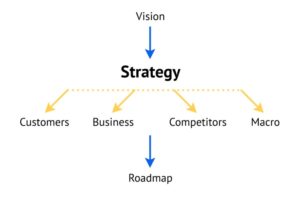A product strategy draws from the ultimate vision of the product. It states where the product will end up. By setting a product strategy, you can determine the direction of your product efforts.
Similar to making effective use of a map, you first need a destination, and then you can plan your route. Just as a business has a strategic vision of what it wants to be when it grows up, the product has its own strategy and destination.

The product strategy forms the basis for executing a product roadmap and subsequent product releases. The product strategy enables the company to focus on a specific target market and feature set, instead of trying to be everything to everyone.
Elements of a product strategy
When defining your product strategy be sure to answer the following questions.
Note that each question below links to an article that further develops the topic, so make sure to review the linked articles as you create your strategy.
Who are you selling to?
Define your target customer or market. Identify whom you are selling to, and what that market looks like.
What are you selling?
Describe how potential customers will perceive your product compared to competitive products. Understand what makes your product unique in the market.
What value do you provide your customers?
Determine what problems your product solves for customers. You cannot be everything to everyone within a particular market, but you can help to solve specific problems. Create a value proposition to position the value you provide and the benefits that customers will receive with your solution.
How will you price your product?
State how you will price the product. Include its perceived value and a pricing model.
How will you distribute your product?
Describe how you will sell your product, and how your target market will acquire your product.
Creating your product strategy
To create your product strategy, start with identifying the market problems you would like to solve. This includes interviewing your target market, understanding the competitive landscape and identifying how you will differentiate yourself.
Your product strategy will change over time as you learn more about your market, and as (if) you decide to enter different markets. Listening to your market and developing your product strategy is a circular process; as you learn more, you will evolve your product strategy and the problems you solve.
Example: Product strategy
Here is a brief example of a product strategy. Your product strategy will vary, and will probably be longer, but should follow the theme of the five questions above.
- We build quality kitchen hardware for residential kitchen customers.
- Our customers are young North American families who want kitchen hardware that can stand the wear and tear of young children. They are interested in materials that are safe for children and eco-friendly.
- We sell our products through a retail channel.
- Our products are priced per unit, and are considered “high-end” hardware solutions.
Power of the product strategy
The power of a product strategy comes from what you define as well as what you exclude. By identifying a particular target market in your product strategy, you are also excluding other markets. This helps your company to understand which projects fall outside the product strategy and distract from strategic goals.

